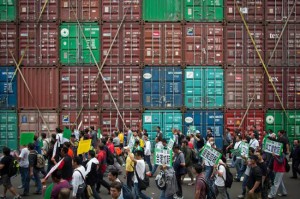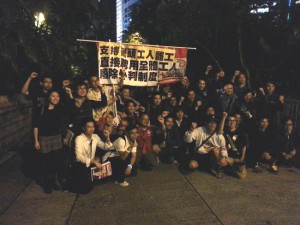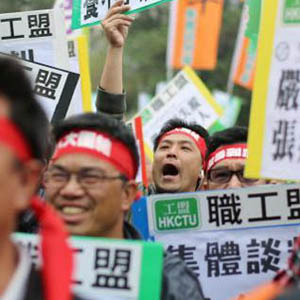Union representatives declare a “half success” with a pay rise of 9.8 percent – but important issues are unresolved
Vincent Kolo, chinaworker.info
The strike by 500 Hong Kong Dockworkers at the world’s third largest container port is over after 40 days. The Hong Kong Confederation of Trade Unions (HKCTU) representing the striking workers reached an agreement for a 9.8 percent pay increase dated from May 1. This was Hong Kong’s longest-running industrial struggle since the famous 1922 Seaman’s Strike (which lasted 55 days). It signals the ‘return’ of class struggle to a city famous as a capitalist beacon, where class warfare is supposedly non-existent. The strike erupted after years of intensified exploitation and worsening conditions especially for outsourced workers, whose real wages are lower today than in the mid-1990s. The strike had a big impact far beyond the port industry, shaking up the wider political landscape and exposing the greed and ruthlessness of port-owner Li Ka-shing, the world’s eighth richest man, and his fellow capitalist tycoons.
The strike showed the decisive role of the working class in society as a force for change, generating huge support including from sections of the middle-class such as the students and social activists. This could be seen throughout the strike despite the fact that in terms of numbers only a minority of dockworkers took part. Imagine the impact of future class battles when thousands and tens of thousands of workers are involved.

What has the strike achieved?
The HKCTU have described the result as “half successful”. The strike managed to pressure the employers to lift their initial pay offer to 9.8 percent, from their original position of “5 percent plus 2 percent” (including fringe benefits). The settlement reached on May 6 leaves a number of unanswered questions however.
Many workers are frustrated they did not achieve a “double-digit increase”. Having lowered the workers’ initial 20 percent wage claim, HCKTU negotiators repeatedly stated they would not settle for anything less than a double-digit increase. The bosses deliberately set their 9.8 percent ‘final offer’ below this symbolically important level. For the capitalists this was not so much about dollars and cents, but about winning a psychological victory on this point.
A mass meeting of strikers on 3 May rejected the very 9.8 percent offer that was accepted three days later. That one-fifth of the strikers reportedly voted against the deal even at the May 6 meeting points to some serious misgivings. But there was also a feeling among many that this was the best that could be achieved after nearly six weeks of struggle, with the employers’ side maintaining an aggressive line and announcing they would not return to the negotiating table.
This impressive strike movement holds many lessons for the wider workers’ movement. It is necessary to draw up a balance sheet – to recognize what the struggle has achieved, but also to address the question: Should the strikers have held out for a better deal? The HKCTU leaders and many of the strike’s supporters from within the NGO and student activist layer have in our opinion presented too upbeat a view of the settlement, ignoring vital questions about whether and through what strategy more could have been won. It is not enough to state generalities as some are now doing such as “the struggle will continue but in a different form…”
This could be said of all strikes. But for workers who have made big economic sacrifices in the course of this struggle, and in some cases whose jobs are under threat, a more serious evaluation is needed. Socialists Action (supporters of the CWI in Hong Kong) has actively supported the strike throughout (including raising almost HK$36,000 – US$4,600 equivalent – for the strike funds). We have proposed and assisted with concrete measures such as early morning leafleting to appeal to non-striking workers. We pointed to the success of a more offensive approach as shown by the mass road blockade that developed spontaneously on April 25, temporarily closing access to the port terminal at Kwai Tsing and winning support from truck drivers. Unfortunately, instead of building upon this example to escalate the strike, the HKCTU leaders viewed this as an isolated incident.
Guarantees for sacked workers?
Another key issue is the fate of around 100 striking workers formerly employed by Global Stevedoring Service, a port subcontractor that went out of business during the strike. The collapse of this company, and dismissal of its workforce, was engineered to exert pressure on the strike. Rather than an independent unit – as the bosses would have us believe – Global and the other subcontractors function as a front for Li Ka-shing’s Hutchison Port Holdings (HPH), the main port operator. The issue of outsourcing and contract labour also remain unresolved, yet this is ultimately the main cause of this dispute.
Clearly, no deal can be regarded as an acceptable end to the strike unless guarantees are obtained for the Global workers who have been a pillar of the strike. Some of these workers told chinaworker.info of their disappointment with how the strike ended. They felt the union leadership had not given sufficient weight to their situation. The HKCTU has announced a return to work on May 9, but this says nothing about provision for the re-employment of Global workers, apart from calling upon the government to ‘help’ find them employment.
While the strike can in many ways serve as a fine example for the wider working class, some crucial lessons must be drawn. At the start of the strike, HKCTU leaders underestimated the fierce resistance of the bosses and seemed to believe the battle for general public sympathy was enough to clinch victory. Especially given that only a minority of the port’s workforce took part in the strike, it is preferable to overestimate rather than underestimate the enemy. The emphasis was too much on demonstrations and rallies, which are also important, but not as a substitute for traditional working class strike methods such as picketing, attempting to block deliveries, and appealing to other workers to come out on strike or ‘black’ work normally done by striking workers. Had these measures been adopted in a systematic way this would have given the strike more ‘bite’.
The leadership of the HKCTU, politically close to and influenced by the pan democratic leaders, instead adopted a cautious stance on many decisive tactical issues for fear of ‘losing public support’. In our opinion this was never a serious risk – public support was overwhelming (with a staggering HK$9 million –equivalent to US$1.16 million – raised for the strike fund from the general public) and there is no contradiction between effective picketing and maintaining strong outside support.
These tactical problems must of course be viewed in the context of vicious attacks from the employers’ side (several subcontracting firms under the wings of Hutchison). They accused the union of waging “class struggle” (as if the bosses themselves were pacifists) and engaged in various dirty tricks to break the strike. This included three high court injunctions to limit the strikers’ ability to picket and protest, recruitment of scab labour, and the ‘bankruptcy’ of Global midway through the strike. Another key obstacle was the scurrilous role of the pro-Beijing yellow union, FTU, which did everything to sabotage the strike and play off the majority of port workers (who did not strike) some of whom are directly employed, against the strikers who work for subcontractors.
As Socialist Action proposed during the strike there was a need to escalate actions at the port terminal, deploying pickets and attempting to block roads, as well as appealing to more workers to join the strike. The court rulings against the strike imposed serious physical restrictions and should have been challenged more vigorously – not through the courts, but through a protest campaign against the blatant class-bias of these rulings. This also poses the question of when it is necessary for workers in struggle to defy unjust laws and how this should be done.
The HKCTU leaders stressed the need to avoid actions that could trigger repression and arrests. This is a serious problem, not to be treated in a light-minded way. But the risk of repression should not become a general argument against picketing to close down as much as possible of the port operations. Had strikers been arrested for exercising their democratic right to picket, this would have generated enormous sympathy, causing an even bigger public backlash against the already unpopular port companies and exerting greater pressure upon them.
In their endeavours to avoid confrontation with the legal authorities, the HKCTU leaders unfortunately limited the effectiveness of the strike and held back from deploying its full force. This in turn enabled Hutchison to maintain a certain level of operations throughout the strike and give the impression after several weeks of strike action of a ‘stalemate’.
The employers and the pro-government camp are already attempting to exploit the end of the strike and particularly the failure to obtain a double-digit pay increase to back up their propaganda to the effect that struggle cannot change anything. Typically, Wong Kwok-kin of the strike-breaking Federation of Trade Unions declared “The strike organiser successfully mobilized various political and community parties to join the strike, [helping it last] for a long time. Even so, the workers failed to achieve their target of a double-digit pay rise and it gives the public the perception that such tactics did not really succeed.”
In reality, however, if the determination and spirit shown by the dockworkers is linked to a fighting strategy, organisation and methods as we have outlined, the working class is an invincible force.

The outsourcing scam
The background to the dockworkers’ strike is a decade-and-a-half of falling real wages and worsening conditions while housing and other daily costs have skyrocketed. Hong Kong dockworkers were earning HK$55-an-hour prior to the strike, less than the HK$60 they were paid in 1995 when port operations were outsourced. The HKCTU has not clearly opposed outsourcing or featured this as a core issue in the current struggle, and yet the problem of outsourcing is absolutely central to the port conflict and must be confronted. In a separate part of Li Ka-shing’s business empire, HKCTU negotiators in April accepted a new outsourcing deal affecting 100 workers at Watsons Water.
Hutchison, like other companies across Asia, uses outsourcing to lower wages, cut sick pay and other entitlements, and to weaken union power. Visiting unionists from Australia and the Netherlands, working at ports also owned by Hutchison (which is the world’s largest container port operator accounting for 13 percent of global capacity), brought solidarity greetings to the Hong Kong strike. But they also revealed the ocean-wide gap between conditions and pay in these ports where unions have successfully blocked outsourcing and forced Hutchison to directly employ workers, and conditions in Hong Kong where outsourcing has run riot.
Visiting workers from the Maritime Workers Union of Australia likened the conditions in Hong Kong to a “living hell” and “akin to slave labour”. They reported that Australian dockworkers receive HK$647,000 (equivalent) a year, for working an eight-hour day, compared to shifts of 12 to 24 hours in Hong Kong for around one-third of this wage ($216,000 a year). The issue of overtime rates (there are no premiums for working night shifts or weekends for outsourced dockworkers in Hong Kong) is another area not covered by the strike settlement. The bosses have merely agreed to “continue discussions” on this point.
Similarly a visiting group of dockworkers from the Dutch port of Rotterdam, who are directly employed by Hutchison, said they earned 50-60 per cent more than their Hong Kong counterparts and worked 178 hours a month, compared to the 330 hours average in Hong Kong.
Build fighting unions
Hong Kong dockworkers do not at this stage have the equivalent degree of union organisation as their counterparts in Australia or Europe. Clearly, union strength and cohesion (given the rotten strikebreaking role of the FTU in Hong Kong) are crucial factors in evaluating what can be achieved in a struggle, including this one. In this sense, we can agree, “the struggle continues” – to take the experience from this strike back into the port in order to build a powerful, democratic and fighting union for dockworkers as a model to other sections of the working class. Socialist Action pledges to continue our assistance to this struggle. But it is also necessary to fully draw out the lessons of this strike, especially in the HKCTU leadership’s overly cautious tactics and reluctance to deploy the full power of the strike in order to block a greater share of the port’s operations. These issues must be addressed in order to achieve victory in future struggles.





